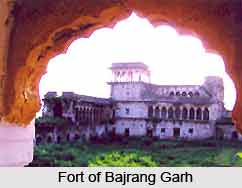
It is approximately 1200 years old, situated in the west of Guna District on the Guna-Aron-Sironj route. A place with abundance of natural flora, made famous in the world by the miraculous idols of Lord Shantinath, Kunthunath and Arahnath in standing posture. Jain Nagar was the older name of the place, which was later changed to Lord Bajrang (Hanuman) Temple in the fort of Bajrang Garh.
This Kshetra shows the broadmindedness of the famous historic businessman Shri Pada Shah, his love and faith for Jainism and the proof of proficiency of architects and artists. Shri Pada Shah built this temple in A.D.1236; he also constructed Jain Temples at many other more Teerth Kshetras. People believe that Pada Shah got hold of a touchstone near this spot, and thus could construct the temple so hastily. In V.S. 1943, some people tried to manhandle the temple, but soon after fire started to rain down, driving the people away in panic. People from all sects and castes come to worship Lord Shantinath, because they feel that by doing so all their desires will be fulfilled.
At this Kshetra the ancient temple of Lord Shantinath stands tall, shooting skywards, the apex of it dating back to more than 800 years old. The principal deity, in standing posture, is 18 feet in height, is all red in colour. Idols of Lord Kunthunath and Arahnath are installed on both the sides of Lord Shantinath, measuring 10 feet and 9 feet respectively. These three Tirthankaras were simultaneously Chakravarty and Kamdeo also. Shri Pada Shah had put up idols of these three saints in other Kshetras also. Numerous other idols of other Lords are also kept here, adding to the temple`s glory. On the walls of the temple captivating pictures connected to mythological stories are inscribed, which is worth a second look. Magnificient Samavsharan Mandir is another place worth a watch. Annual festivals of Kartik Shukla 5, Lord Shantinath`s janma (birth), Tapa and Moksha Kalyankaa celebrated on Jyeshtha Krishna 14 every year. Shri Shantinath Digambara Jain Atishaya Kshetra Bajrang Garh Managing Committee deftly manages the entire infrastructure of the Mandir. For the visiting devotees, two dharamshalas (dormitories) have been built with all kinds modern amenities.
Other remarkable temples nearby are Bhagwan Parsvnath Jinalaya in the main market area, constructed by Shri Jhhitu Shah. Another has been constructed by Shri Harish Chandra Tarka. Gorgeous Trikal Chaubeesee is being designed inside Tarkaji`s temple.











